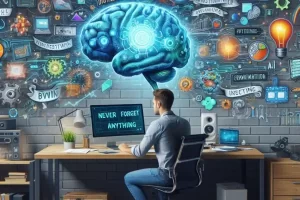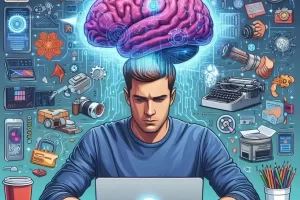Creativity isn’t just for artists — it’s essential for problem-solving, entrepreneurship, decision-making, and personal growth. But creativity doesn’t always arrive on command. That’s why you need a system to nurture, capture, and expand your ideas.
By combining your second brain with the power of artificial intelligence (AI), you can unlock deeper levels of creativity, consistently generate fresh ideas, and turn inspiration into innovation.
In this article, you’ll learn how to use your second brain and AI to build a creative ecosystem — one that turns you into a steady source of original ideas and solutions.
Why Creativity Needs Structure
Most people believe creativity is random or mystical. But in reality, creativity thrives when:
- You have a place to store raw ideas
- You revisit and remix existing concepts
- You reduce mental clutter
- You engage in structured thinking and exploration
- You’re not limited by linear, logical processes alone
Your second brain captures and connects ideas.
AI helps you expand, remix, and evolve them.
Together, they turn creativity into a repeatable process — not a waiting game.
Build a Creative Inbox in Your Second Brain
Start with a place to capture every spark — no matter how incomplete.
Include:
- ✍️ Random ideas and brainstorms
- 🎧 Inspiring quotes, lyrics, podcast clips
- 📚 Notes from books, films, and conversations
- 📷 Visual references or sketches
- 🗣 Voice memos or transcribed thoughts
Use tags like:
- #storyidea
- #visualconcept
- #metaphor
- #innovation
- #unexpected
Let AI help:
“Summarize this voice note into a story idea.”
“Organize these 10 scattered notes into creative themes.”
“What tags would help me revisit these ideas later?”
This creates a frictionless capture system for creative input.
Remix Ideas Using AI and Backlinks
Most great ideas aren’t new — they’re combinations of old ones. Your second brain is perfect for:
- Linking unrelated concepts
- Surfacing forgotten insights
- Spotting patterns in your thoughts
Use AI to:
“Combine this idea about productivity with this note about music.”
“What connections exist between my notes on minimalism and marketing?”
“Generate three creative metaphors based on this concept.”
Now your second brain becomes a network of creativity, not a static vault.
Create Creative Thinking Templates
To make creativity consistent, use prompts and frameworks for idea generation.
Examples:
- 🎯 Problem-reversal (“What’s the opposite of what everyone expects?”)
- 🧠 First principles (“What are the fundamental truths here?”)
- 💬 Story prompts (“What if…?” “Why now?” “What changes everything?”)
- 📦 Constraints framework (“How would I solve this with zero budget?”)
Let AI help build these:
“Create a creative brief template for generating brand campaign ideas.”
“Give me 5 divergent thinking prompts for breaking through mental blocks.”
“What are good prompts to generate wild ideas around this theme?”
This gives you structure without limits.
Turn Raw Ideas Into Drafts, Sketches, or Prototypes
Once you’ve got ideas, start shaping them into something tangible.
AI can help:
“Turn this brainstorm into a blog outline.”
“Sketch a landing page based on this product idea.”
“Summarize this story arc and suggest character roles.”
“Create a pitch for this app idea using my notes.”
You can also build templates for:
- 🎙 Podcast episodes
- 🎥 Video scripts
- 🧵 Social media threads
- 📓 Product concepts
- 🎯 Startup MVPs
Now your creativity is applied, not just imagined.
Track Creative Projects and Workflows
Use your second brain to:
- Manage creative projects (idea → draft → feedback → publish)
- Store inspiration by medium or mood
- Maintain a content or product backlog
- Track “incubating” ideas (not ready yet)
Ask AI:
“What’s the status of all creative ideas in progress?”
“Which of my past concepts haven’t been tested yet?”
“Suggest 3 next actions for finishing this creative piece.”
This gives you a creative pipeline, not just a folder of unfinished ideas.
Reflect on Your Creative Identity and Evolution
Ask yourself:
- What themes do I return to most often?
- What inspires me lately — and why?
- What kind of creator am I becoming?
- What do I want to say that only I can say?
AI can guide you:
“Analyze my creative notes — what patterns emerge in my thinking?”
“What projects represent my creative voice best?”
“Help me write a creative mission statement based on my work.”
This helps you build a coherent creative identity, not just outputs.
Make Creativity a Daily Practice
Creativity isn’t just a talent — it’s a muscle. Strengthen it with:
- 🧘 Daily idea capture
- 🎨 20-minute creativity sprints
- 🔁 Weekly remix sessions
- 📅 Scheduled play, exploration, or “creative wandering”
- 🧠 Prompted reflection on inspiration and resistance
Let AI support you:
“Give me a 10-minute creative challenge today.”
“What’s one new angle I haven’t explored yet in this theme?”
“Suggest a creative warm-up before writing or designing.”
Now, instead of waiting for inspiration, you’re training creativity like a skill.
Real-Life Example: The Multidisciplinary Creator
You’re a designer, writer, and strategist building multiple projects.
Your second brain includes:
- A categorized vault of creative prompts, sketches, and themes
- AI that connects old ideas with new opportunities
- Templates for content, client projects, and experiments
- A daily creativity log with wins, blocks, and breakthroughs
- Weekly reviews of what sparked the most curiosity
You no longer fear creative droughts — your system keeps you inspired and progressing.
Final Thoughts: Creativity Is a System, Not a Secret
You don’t need to wait for lightning to strike. With your second brain and AI:
- You capture ideas before they disappear
- You remix and evolve your thinking over time
- You turn creativity into content, strategy, or innovation
- You grow your unique voice and creative fingerprint
- You stay consistent — even when motivation dips
Design the system. Feed your mind. Collaborate with your tools.
And let your creativity become a daily, dependable source of growth.




